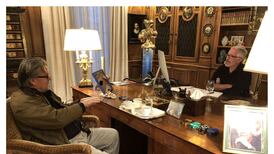A human-factors expert will join the investigation of the fatal crash of Virgin Galactic’s passenger spacecraft to study why the co-pilot prematurely unlocked a pivoting tail section of the ship during a test flight, the National Transportation Safety Board chairman said yesterday.
The untimely engagement of the tail mechanism, designed to slow the vehicle’s descent into the atmosphere from space, and the possibility that pilot error was to blame, were disclosed by the NTSB late on Sunday and have emerged as a main thrust of the inquiry into Friday’s accident.
The suborbital rocket vehicle dubbed SpaceShipTwo broke into pieces over California’s Mojave Desert and crashed shortly after its separation from the special jet aircraft that carries it aloft for its high-altitude launches.
The accident, which unfolded without SpacesShipTwo catching fire or exploding in flames, came on its fourth powered test flight, the first since January.
Video footage from the cockpit shows co-pilot Michael Alsbury, 39, who died in the crash, releasing a lever to unlock the twin-tail section too soon after the space plane was jettisoned from the mother ship over Southern California.
This was followed two seconds later by the premature movement of the tail, which pivots upward from the rear of the wings at a 90-degree angle and increases aerodynamic drag on the spacecraft.
Still, NTSB Chairman Christopher Hart said that investigators have yet to determine whether releasing the tail mechanism too early caused or contributed to the crash of the space plane near the Mojave Air and Space Port, about 152 km north of Los Angeles.
“We know already from having the lever move from lock to unlock that we need to get a human-factors person in here because the question then is why did that happen when it happened,” Mr Hart said. “The human-factors person will be here today.”
Asked if pilot error was a possible factor, Mr Hart said: “We are looking at all of these issues to determine what was the root cause of this mishap ... including that possibility.”
Mystery of pilot’s survival
Investigators are also trying to determine how surviving pilot Pete Siebold (43) managed to get out of the rocket plane and parachute to the ground from a height of roughly 50,000 ft, an altitude virtually devoid of oxygen.
Mr Hart said Mr Siebold, now hospitalized with a shoulder injury, did not exit through the cockpit’s escape hatch.
“We know it wasn’t through there, so how did this pilot get out?” he said.
Also unclear was how exactly the tail mechanism, once it was unlocked, began to rotate, since that maneuver requires a separate pilot command that was never given, he added.
This raised questions about whether the craft’s position in the air and its speed somehow enabled the tail section to swing free on its own.
SpaceShipTwo was released normally from the carrier jet WhiteKnightTwo at an altitude of about 45,000 ft.
The rocket motor, fueled for the first time in flight with a new plastic-based propellant formula, then ignited as planned, Mr Hart said.
SpaceShipTwo’s fuel tanks and engine were recovered intact, indicating there was no explosion. “The engine burn was normal up until the extension of the feathers,” he said.
About 800 people have paid or put down deposits for a ride into space at $250,000 a seat, and Richard Branson plans to be on the first commercial flight with his son.
Mr Branson said yeserday y his company’s venture was “absolutely” worth the risks. “It’s a grand program, which has had a horrible setback, but I don’t think anybody... would want us to abandon it at this stage,” he told NBC.
Virgin Galactic is about two-thirds finished building the second of its five planned space tourism vehicles, and was determining how the crash probe would alter its production schedule, chief executive George Whitesides said.
Virgin Galactic is a US offshoot of the London based Virgin Group founded by Branson, whose empire ranges from airlines to music stores and mobile phones.
Reuters










